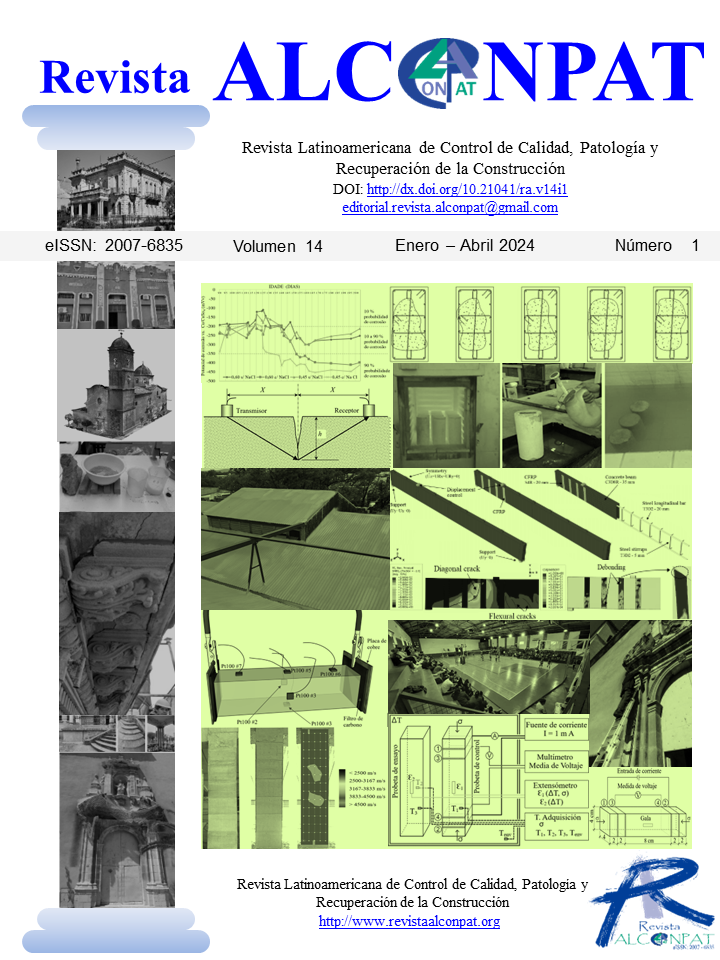Effect of carbonaceous nanoadditions on strain sensing and heating functions in cement pastes
DOI:
https://doi.org/10.21041/ra.v14i1.713Keywords:
nanoadditions, strain sensing, cement pastes, heating, resistivityAbstract
In this research, the use of conductive nanoadditions, such as carbon nanotubes (CNT) and graphite products (GP), in cement specimens has been studied to develop strain sensing and heating functions. For this purpose, cement paste specimens with addition of 1% CNT and 5% GP have been fabricated and heating tests have been performed in direct current (DC) and alternating current (AC) at 20 V and 40 V. In addition, the influence of temperature on the strain sensing tests in the range from 0 °C to 60 °C has been studied, obtaining good results in both techniques. Therefore, these materials offer a very interesting alternative in structural monitoring and may have applications in the heating of infrastructures such as bridges and airports, avoiding the use of corrosive substances.
Downloads
References
Allam, H., Duplan, F., Clerc, J. P., Amziane, S., Burtschell, Y. (2020). About electrical resistivity variation during drying and improvement of the sensing behavior of carbon fiber-reinforced smart concrete. In Construction and Building Materials (Vol. 264). https://doi.org/10.1016/j.conbuildmat.2020.120699
Baeza, F. J., Galao, O., Zornoza, E., Garcés, P. (2013a). Effect of aspect ratio on strain sensing capacity of carbon fiber reinforced cement composites. Materials and Design, 51, 1085–1094. https://doi.org/10.1016/j.matdes.2013.05.010
Baeza, F. J., Galao, O., Zornoza, E., Garcés, P. (2013b). Multifunctional cement composites strain and damage sensors applied on reinforced concrete (RC) structural elements. Materials, 6(3), 841–855. https://doi.org/10.3390/ma6030841
Baeza, F. J., Ivorra, S., Bru, D., Varona, F. B. (2018). Structural health monitoring systems for smart heritage and infrastructures in Spain. Intelligent Systems, Control and Automation: Science and Engineering, 92, 271–294. https://doi.org/10.1007/978-3-319-68646-2_12
Banthia, F. A. and N. (n.d.). Carbon Fiber-Reinforced Cementitious Composites for Tensile Strain Sensing. ACI Materials Journal, 114(1). https://doi.org/10.14359/51689486
Camacho-Ballesta, C., Zornoza, E., Garcés, P. (2016). Performance of cement-based sensors with CNT for strain sensing. Advances in Cement Research, 28(4), 274–284. https://doi.org/10.1680/adcr.14.00120
Carmona, J., Climent, M.-Á., Antón, C., De Vera, G., Garcés, P. (2015). Shape Effect of Electrochemical Chloride Extraction in Structural Reinforced Concrete Elements Using a New Cement-Based Anodic System. In Materials (Vol. 8, Issue 6). https://doi.org/10.3390/ma8062901
Chung, D. D. L. (1998). Self-monitoring structural materials. 22.
Chung, D. D. L. (2004). Self-heating structural materials. In Smart Materials and Structures (Vol. 13, Issue 3, pp. 562–565). https://doi.org/10.1088/0964-1726/13/3/015.
del Moral, B., Galao, Ó., Antón, C., Climent, M. A., Garcés, P. (2013). Viabilidad de utilización de una pasta de cemento con nanofibras de carbono como ánodo en la extracción electroquímica de cloruros en hormigón. Materiales de Construccion, 63(309), 39–48. https://doi.org/10.3989/mc.2012.03111.
del Moral, B. Baeza, F.J., Navarro, R. Galao, O., Zornoza, E., Vera, J., Farcas, C., Garcés, P. Temperature and humidity influence on the strain sensing performance of hybrid carbon nanotubes and graphite cement composites. Construction and Building Materials 284 (2021) 122786. https://doi.org/10.1016/j.conbuildmat.2021.122786.
Published
How to Cite
Issue
Section
License
_______________________________
License in effect from September 2020
You are free to:
- Share — copy and redistribute the material in any medium or format for any purpose, even commercially.
- Adapt — remix, transform, and build upon the material for any purpose, even commercially.
- The licensor cannot revoke these freedoms as long as you follow the license terms.
Under the following terms:
- Attribution — You must give appropriate credit , provide a link to the license, and indicate if changes were made . You may do so in any reasonable manner, but not in any way that suggests the licensor endorses you or your use.
- No additional restrictions — You may not apply legal terms or technological measures that legally restrict others from doing anything the license permits.
Notices:
You do not have to comply with the license for elements of the material in the public domain or where your use is permitted by an applicable exception or limitation .
No warranties are given. The license may not give you all of the permissions necessary for your intended use. For example, other rights such as publicity, privacy, or moral rights may limit how you use the material.





















.png)














